 Goose and goslings feeding in a public park at the north end of Jackson Hole, Wyoming.
Goose and goslings feeding in a public park at the north end of Jackson Hole, Wyoming.  A frontier style fort like building that houses the offices of Attorney Gerry Spence. Spence is a famous lawyer with a reputation of taking on high profile clients, including: former Philippine First Lady Imelda Marcos, Randy Weaver, a white separatist involved in a shootout with the FBI in Idaho and was a member of O.J. Simpson’s “Dream Team.” He claims to have never lost a criminal case.
A frontier style fort like building that houses the offices of Attorney Gerry Spence. Spence is a famous lawyer with a reputation of taking on high profile clients, including: former Philippine First Lady Imelda Marcos, Randy Weaver, a white separatist involved in a shootout with the FBI in Idaho and was a member of O.J. Simpson’s “Dream Team.” He claims to have never lost a criminal case.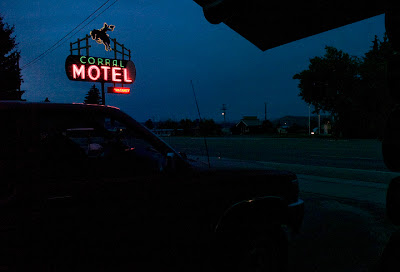 The Corral Motel neon-sign, in Afton, Wyoming.
The Corral Motel neon-sign, in Afton, Wyoming.  World’s largest Elkhorn arch, Afton, Wyoming.
World’s largest Elkhorn arch, Afton, Wyoming.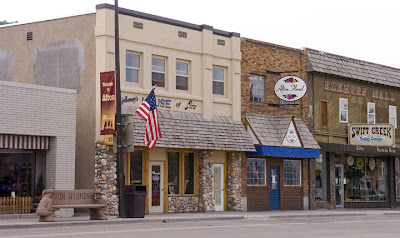 Concrete molded to look like a cowboy and cowgirl are holding up the bench in Afton, Wyoming.
Concrete molded to look like a cowboy and cowgirl are holding up the bench in Afton, Wyoming.Idaho
 Signal man on an Idaho road construction project.
Signal man on an Idaho road construction project.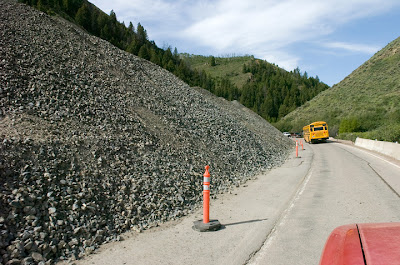 “Watch For Rocks” signs are one of the most common roadside warnings; here the sign means it. A huge pile of rocks covers opposing lanes of traffic along the Montpelier Canyon Rd. construction project in Idaho between Geneva and Montpelier.
“Watch For Rocks” signs are one of the most common roadside warnings; here the sign means it. A huge pile of rocks covers opposing lanes of traffic along the Montpelier Canyon Rd. construction project in Idaho between Geneva and Montpelier.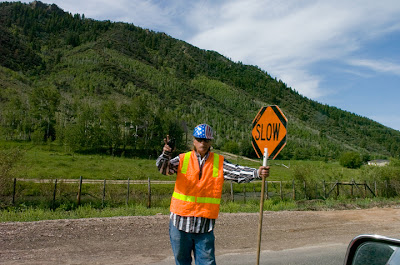 A patriotically clad signal man throws a peace sign at the other end of the road construction project.
A patriotically clad signal man throws a peace sign at the other end of the road construction project.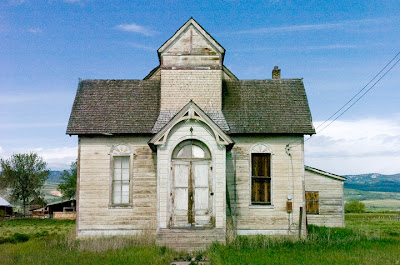 An abandoned church at Ovid, Idaho.
An abandoned church at Ovid, Idaho. 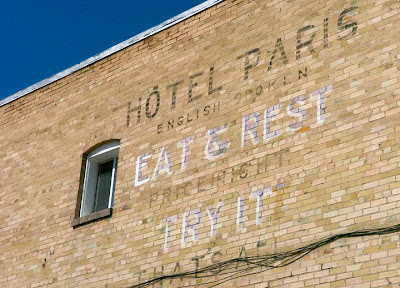 Hotel Paris in Paris, Idaho had faded paint announcing “English spoken.”
Hotel Paris in Paris, Idaho had faded paint announcing “English spoken.” The Bear Lake County courthouse in Paris, Idaho.
The Bear Lake County courthouse in Paris, Idaho.  The jury-box in Bear Lake County courtroom.
The jury-box in Bear Lake County courtroom. The Bear Lake County courtroom.
The Bear Lake County courtroom.A little trivia fact I picked up; Idaho is the only state in the union that had never been part of or claimed by another country.
Utah
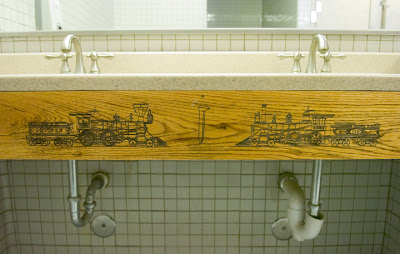 The art on wood shows up again, this time not on a table, but at the sink in the men’s room at the Golden Spike National Historic Park at Promontory Point, Utah.
The art on wood shows up again, this time not on a table, but at the sink in the men’s room at the Golden Spike National Historic Park at Promontory Point, Utah.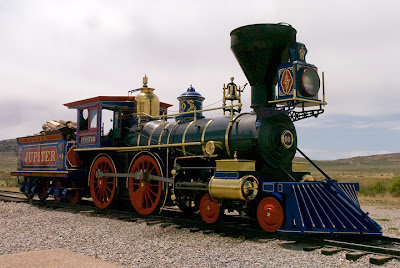 The park has a historic display of the two replicated engines that met to drive the Golden Spike linking the east and west coasts by rail on May 10, 1869.
The park has a historic display of the two replicated engines that met to drive the Golden Spike linking the east and west coasts by rail on May 10, 1869.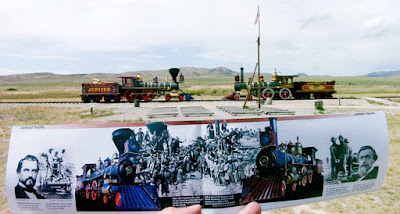 The Jupiter, representing the Central Pacific Railroad, on the left, had laid 960 miles of track through the Sierra Nevada, while the Union Pacific Railroad, represented by engine No. 119 laid 1,086 miles of track. Congress had granted loans and provided that the railroad would get 10 sections of land for every mile of track they laid.
The Jupiter, representing the Central Pacific Railroad, on the left, had laid 960 miles of track through the Sierra Nevada, while the Union Pacific Railroad, represented by engine No. 119 laid 1,086 miles of track. Congress had granted loans and provided that the railroad would get 10 sections of land for every mile of track they laid.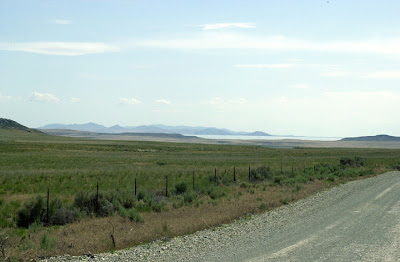 There is a self-guided auto tour that offers visitors a view of how the railroad was built. Here the road is over the Union Pacific grade at Promontory Hollow, with the Great Salt Lake visible in the background.
There is a self-guided auto tour that offers visitors a view of how the railroad was built. Here the road is over the Union Pacific grade at Promontory Hollow, with the Great Salt Lake visible in the background.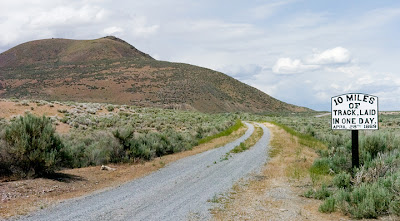 The Central Pacific crews laid 10 miles in a day in a $10,000 bet as a response to the Union Pacific having laid six miles in a day. The Union Pacific was unable to attempt to out do that feat because the remaining distance was over the roughest terrain it had yet encountered.
The Central Pacific crews laid 10 miles in a day in a $10,000 bet as a response to the Union Pacific having laid six miles in a day. The Union Pacific was unable to attempt to out do that feat because the remaining distance was over the roughest terrain it had yet encountered. 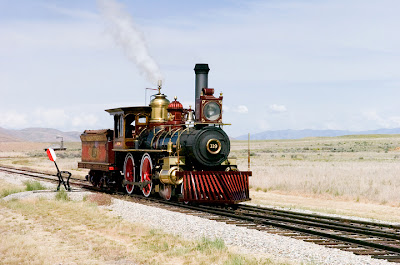 The Union Pacific Railroad engine No. 119 replica switching tracks during a demonstration of the technology that brought together the continent.
The Union Pacific Railroad engine No. 119 replica switching tracks during a demonstration of the technology that brought together the continent.  Across the hill from the National Park site is another kind of world shrinking technological display. Morton Thiokol and ATK, an advanced weapon and space systems company, show examples of their hardware in a rocket garden.
Across the hill from the National Park site is another kind of world shrinking technological display. Morton Thiokol and ATK, an advanced weapon and space systems company, show examples of their hardware in a rocket garden. Included on display is a solid rocket booster for the Space Shuttle, communications satellite rockets and the Trident Ballistic missile.
Included on display is a solid rocket booster for the Space Shuttle, communications satellite rockets and the Trident Ballistic missile. 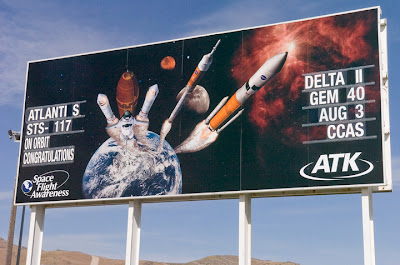 A billboard announcing the recent accomplishment of placing the Space Shuttle in orbit and the pending launch of a Delta II Gem 40 rocket.
A billboard announcing the recent accomplishment of placing the Space Shuttle in orbit and the pending launch of a Delta II Gem 40 rocket.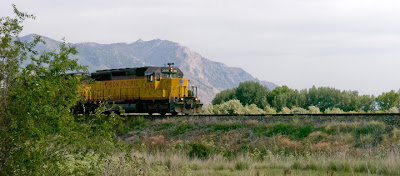 A current Union Pacific freight train about 30 miles east of Promontory Point, near Brigham City.
A current Union Pacific freight train about 30 miles east of Promontory Point, near Brigham City.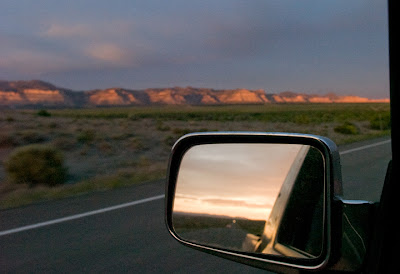 The sun sets in the rearview mirror along the Dinosaur Diamond Prehistoric Highway.
The sun sets in the rearview mirror along the Dinosaur Diamond Prehistoric Highway.New Mexico
 Cabezon Peak in the Rio Puerco valley. Part of the Navajo legend of the twins, the originators of the people, who fought and killed the “Giant.” Mount Taylor, one of the four sacred Navajo mountains, is where the giant died. The Malpais lava flow was thought by the ancients as being the blood of the giant. Cabezon was the giants severed head.
Cabezon Peak in the Rio Puerco valley. Part of the Navajo legend of the twins, the originators of the people, who fought and killed the “Giant.” Mount Taylor, one of the four sacred Navajo mountains, is where the giant died. The Malpais lava flow was thought by the ancients as being the blood of the giant. Cabezon was the giants severed head. 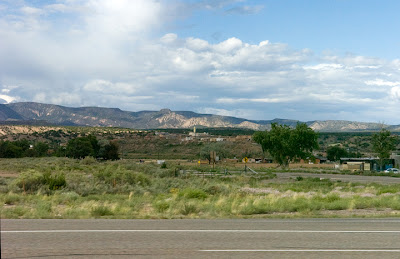 Zia Pueblo at the base of the Jemez mountain range means my home is around the corner.
Zia Pueblo at the base of the Jemez mountain range means my home is around the corner.
No comments:
Post a Comment